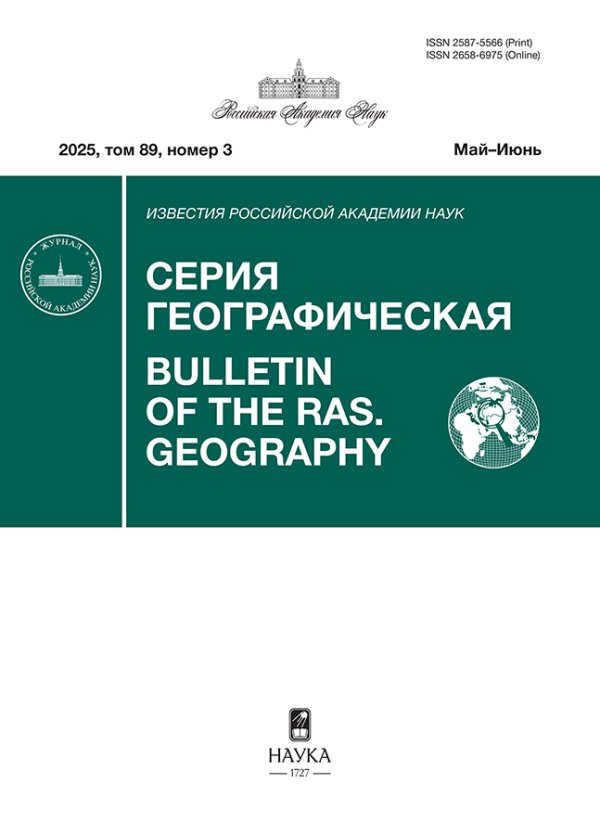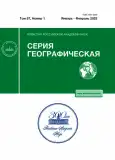Городские агломерации Казахстана: тенденции социально-экономического развития
- Авторы: Махрова А.Г.1, Сафронов С.Г.1, Абилов А.Ж.2
-
Учреждения:
- Московский государственный университет имени М.В. Ломоносова, географический факультет,
- Казахский национальный исследовательский технический университет им. К.И. Сатпаева
- Выпуск: Том 87, № 1 (2023)
- Страницы: 16-28
- Раздел: ТЕРРИТОРИАЛЬНАЯ ОРГАНИЗАЦИЯ ОБЩЕСТВА
- URL: https://journals.rcsi.science/2587-5566/article/view/135565
- DOI: https://doi.org/10.31857/S2587556623010119
- EDN: https://elibrary.ru/LKERDP
- ID: 135565
Цитировать
Полный текст
Аннотация
Статья посвящена современному этапу развития агломераций Казахстана, стимулирование формирования которых стало одним из приоритетов государственной политики. Из-за отсутствия критериев границы потенциальных агломераций определены по полуторачасовым изохронам транспортной доступности вокруг городов людностью от 100 тыс. чел. Из этих городов на основе модифицированного коэффициента развитости, учитывающего кроме городских спутников также села людностью свыше 3 тыс. чел., было отобрано восемь центров. На основе ряда социально-экономических индикаторов был проанализирован уровень отрыва ядер агломераций от пригородов и регионов в целом. Пример Казахстана показал, что унаследованная структура экономики и невысокая комфортность среды городов-центров не способствуют развитию большинства агломераций. В течение постсоветского периода их доля в населении республики выросла с 43 до 52%, но административный вариант создания агломераций работает лишь там, где есть объективные предпосылки и эволюционный задел. Из агломераций, статус которых закреплен в правительственных документах в качестве точек роста, к развитым относится агломерация Алматы. Зона тяготения Шымкента включает в основном крупные села, некоторые из которых недавно стали городами. Столичная агломерация Астаны по уровню развитости заметно уступает даже соседней Карагандинской. Актобе способно привлечь жителей лишь северо-западных областей из-за низкой транспортной связности с остальной территорией страны. По показателям социально-экономического развития выделяются столичные агломерации, к которым по степени терциаризации экономики тяготеет третья по величине – Шымкентская. В остальных агломерациях сохраняется повышенная индустриальная занятость, а рост численности населения ввиду невысокой привлекательности происходит за счет естественного прироста и внутриобластной миграции. Кроме Алматы, в окружении которой наблюдаются признаки субурбанизации, города-ядра растут быстрее зон влияния. Пригороды отличает недостаток мест приложения труда, слабость социальной инфраструктуры, более низкий уровень доходов населения. Такая ситуация, характерная для начальных стадий развития, сдерживает использование преимуществ агломераций.
Ключевые слова
Об авторах
А. Г. Махрова
Московский государственный университет имени М.В. Ломоносова, географический факультет,
Автор, ответственный за переписку.
Email: almah@mail.ru
Россия, Москва
С. Г. Сафронов
Московский государственный университет имени М.В. Ломоносова, географический факультет,
Автор, ответственный за переписку.
Email: saffff@mail.ru
Россия, Москва
А. Ж. Абилов
Казахский национальный исследовательский технический университет им. К.И. Сатпаева
Автор, ответственный за переписку.
Email: aabilov1@mail.ru
Казахстан, Алматы
Список литературы
- Абилов А.Ж., Кусаинова Г.К., Махрова А.Г. Социологические исследования при анализе формирования городских агломераций Казахстана (на примере Астаны) // Вестн. Моск. ун-та. Сер. 5. География. 2017. № 4. С. 75–83.
- Акимжанов Х.Р., Сафронов С.Г. Социально-экономическая трансформация территориальной структуры Карагандинской агломерации // Региональные исследования. 2014. № 2. С. 86–96.
- Антонов Е.В., Махрова А.Г. Крупнейшие городские агломерации и формы расселения надагломерационного уровня в России // Изв. РАН. Сер. геогр. 2019. № 4. С. 31–45.
- Афонцев С., Зубаревич Н. Пространственное развитие как механизм модернизации Республики Казахстан // Вопр. экономики. 2012. № 5. С. 53–58. https://doi.org/10.32609/0042-8736-2012-5-53-58
- Голубчиков О.Ю., Бадьина О.В. Макрорегиональные тенденции развития городов бывшего СССР // Региональные исследования. 2016. № 2. С. 31–42.
- Жумасултанов Т.Ж., Ибраев А.Т. Население Казахстана с древнейших времен до наших дней. Алматы: КИИТУ, 2000. 152 с.
- Искалиев Д.Ж. Городское расселение Казахстана: тенденции и факторы // Наука. Инновации. Технологии. 2017. № 2. С. 131–146.
- Лаппо Г.М. Развитие городских агломераций в СССР. М.: Наука, 1978. 152 с.
- Маршалл А. Принципы политической экономии. М.: Прогресс, 1983. Т. 1. 416 с.
- Кириллов П.Л., Махрова А.Г. Сценарии демографического развития агломераций Казахстана // Демографическая ситуация в Казахстане: состояние и перспективы. Вопросы истории и археологии Западного Казахстана. 2011. № 2. С. 10–22.
- Махрова А.Г., Сафронов С.Г. Тенденции развития агломераций Казахстана в XXI в. // Экологические проблемы и устойчивое развитие регионов и городов Республики Казахстан: Материалы Междунар. научн.-практ. конф., посвященной 30-летию Республики Казахстан и 20-летию Казахстанского филиала Московского университета. Нур-Султан, 2021. С. 34–44.
- Нефедова Т.Г., Слепухина И.Л., Браде И. Миграционная привлекательность городов на постсоветском пространстве на примере России, Украины и Беларуси // Изв. РАН. Сер. геогр. 2016. № 2. С. 27–38. https://doi.org/10.15356/0373-2444-2016-2-27-38
- Полян П.М. Методика выделения и анализа опорного каркаса расселения. Ч. 1. М.: АН СССР, Ин-т географии, 1988. 220 с.
- Полян П.М. Территориальные структуры – урбанизация – расселение. Теоретические подходы и методы изучения. М.: Новый Хронограф, 2014. 788 с.
- Jacobs J. The Economy of Cities. N.Y.: Random House, 1969. 268 p.
- Nyussupova G., Sarsenova I. Modern demographic processes in urban areas of the Republic of Kazakhstan // Bul. of Geography. Socio-economic Series. 2012. Vol. 18. P. 99–108.
- OECD Urban Policy Reviews: Kazakhstan. Paris: OECD Publ., 2017. 276 p.
- Zubarevich N.V. Concentration of the population and economy in the capitals of post-Soviet countries // Reg. Res. Russ. 2018. Vol. 8. № 2. P. 141–150.
Дополнительные файлы
















